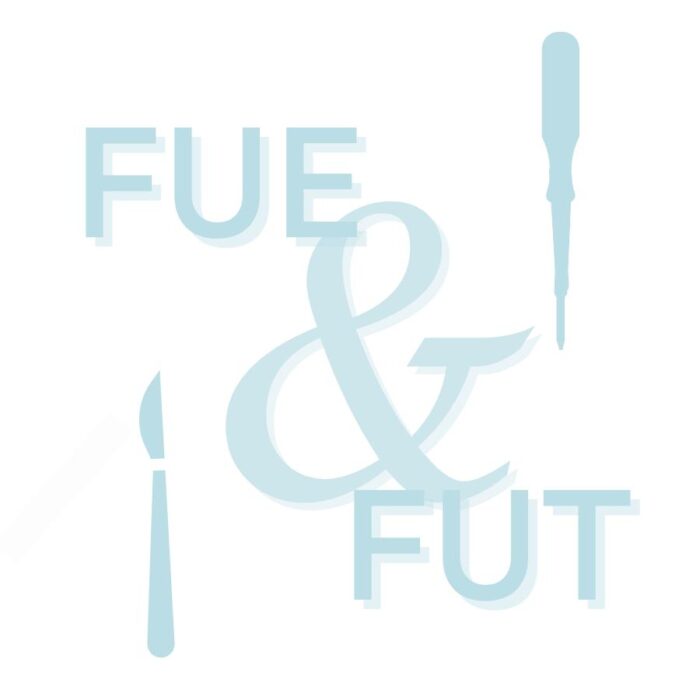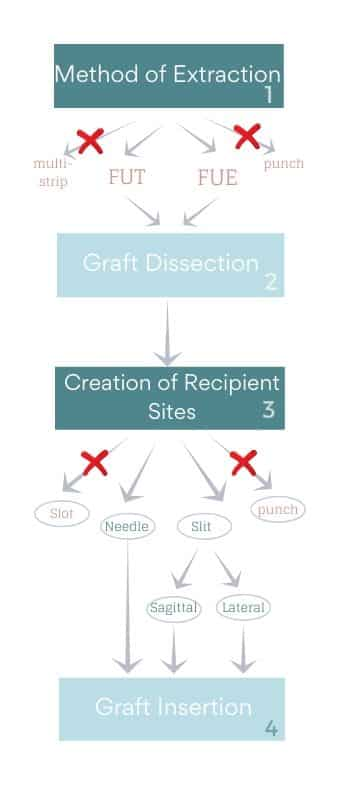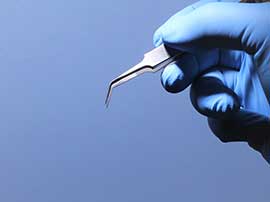
What Makes our FUE and FUT Hair Transplant Techniques Special?
At our centre in Edmonton, Dr. Nakatsui has done 1000s of successful FUE and FUT hair restoration procedures on men and women for over 19 years on patients from all over Canada and from as far away as Australia. He is a Board Certified Dermatologist and is one of the most experienced hair transplant surgeons in Canada. We have also been awarded the Consumer Choice Award for excellence in hair restoration surgery.
His technique differs from many others in several ways, including the use of lateral slits, dense packing, and custom made implanters (yes, they are truly custom made for us and cannot be bought commercially). In addition, if FUT is chosen as your technique, he is one of the few physicians in North America capable of doing >4000 grafts in one session.


We are often asked which is the best hair transplant technique for me (FUE vs FUT). Although it is sometimes an easy answer, there are a number of variables that should be considered, such as density and coarseness of the donor and recipient areas, age of the patient, type of hairstyle, curliness of the hair, and family history.
In this section, we will discuss every step involved in a hair transplant (FUE and FUT) at our centre.
Contact Us For A Hair Transplant Evaluation
Dr. Thomas Nakatsui MD FRCPC FAAD
Serving Edmonton, St. Albert, Sherwood Park, and Calgary
Questions about FUE or FUT surgeries? Contact us at:
780-482-1414
STEP ONE
Methods for Hair Follicle Extraction (FUE vs FUT)
There are many techniques for harvesting donor hair and surgeons vary in how they approach extraction of the donor hair. It is important to use the techniques that have the smallest chance of damaging hair follicles, as these are irreplaceable. At Nakatsui DermaSurgery, we use two of the possible methods for harvesting hair follicles for our surgeries–which method is used depends on the needs and characteristics of the individual patient. We do not use the multi-strip or punch method to extract hairs. The two surgical methods we use to extract hair are known as Follicular Unit Transplantation (FUT) and Follicular Unit Excision (FUE).

Follicular Unit Hair Transplantation (FUT)
The first extraction method Dr. Nakatsui uses to extract healthy hair is known as Follicular Unit Transplantation (FUT). He first started doing FUT over 19 years ago and there have been many advancements since he first started using the technique. FUT involves the harvesting of follicular units using a single-bladed scalpel from the back and sides of the scalp in a single strip or ellipse. This is not the same technique that some surgeons perform using a special scalpel called a multi-bladed scalpel, which yields several strips at once.
FUT is a more time-consuming technique than the multi-strip method but FUT is extremely efficient because over three to four thousand grafts can be obtained from a single ellipse.
This is an extremely common method for harvesting donor hair, although follicular unit excision (FUE) is very commonly used as well. In our clinic, FUT accounts for approximately 40% of our cases.
Follicular Unit Excision (FUE)
The second extraction method Dr. Nakatsui uses is called Follicular Unit Excision (FUE). This technique is gaining a lot of popularity and about 60% of our cases are now FUE. The reason for its popularity is that it leaves such tiny, imperceptible marks that patients can still trim their hair extremely short after a procedure without anyone noticing anything has been done. Many people consider FUE to be a minimally invasive surgical treatment because there is no scalpel and there are no stitches. Each individual follicular unit is incised using a very small punch. Once this has been accomplished, the follicles are extracted from the skin leaving tiny spots. These heal very quickly and frequently leave invisible scarring.
Other Harvesting Techniques
Other harvesting techniques such as multi-bladed scalpels can be used to generate multiple strips simultaneously and larger multi follicular unit grafts, as can be found in the mini-micrografting technique. Some surgeons will claim that transplanting larger multi-follicular unit grafts (MFUG) is the same thing as transplanting only follicular unit grafts because the number of hairs is the same, but this is not the case. Although it is much faster and easier to transplant MFUGs, the price you pay is a decrease in naturalness and an increase in detectability. Our patients tell us that naturalness and undetectability are very important to them and frankly, it is just as important to us. Consequently, we no longer use larger grafts such as slot grafts, minigrafts, and multi-follicular unit grafts and are committed to using 100% follicular units.
Choosing the extraction technique is the first step in any hair transplant procedure and once we have made the decision on FUE vs FUT, we are well on the way to deciding what is the best hair restoration technique for you.
It is important to remember the method of extraction (FUT and FUE) is only the first step in the hair restoration procedure. Once the grafts have been harvested with either FUT or FUE, the grafts still need to be dissected and refined (Step 2). Following this, the recipient sites need to be created (Step 3) and then the follicular unit grafts need to be transplanted into tiny incisions made in the bald or thinning areas of the scalp (Step 4) where they will resume their growth.

STEP TWO
Graft Dissection (FUE vs FUT)
No matter which hair extraction technique is used–either FUE or FUT–the extracted grafts need to be dissected so that excess bald tissue can be safely removed. Using high-powered stereomicroscopes, the hair is separated into their naturally occurring bundles of one to three hairs without being damaged.
Depending on the hair restoration surgeon, the grafts can be dissected out in different ways. One of the major differences is whether grafts are “skinny” or “chubby”. In other words, is the excess bald tissue around each follicular unit dissected away tightly to the hair follicles or is there a large amount of residual tissue left over? Chubby grafts have the benefit of increased resistance to trauma and dessication, but with an experienced implanter, these are of minimal concern. On the other hand, tightly dissected grafts can be placed closer together to yield higher density and heal incredibly well without pitting or protrusion. If excess tissue is left around the superficial part of the graft, there is a higher chance of surface aberrations around the grafts.
Although time-consuming, microscopic dissection is more accurate and produces grafts that require smaller recipient sites that can be placed closer together (i.e. denser), with faster and better healing.

With FUE, very little extra dissection is needed because the extracted grafts already have very little tissue surrounding them when they are extracted. In fact, one of the downsides of FUE is that the extracted grafts may sometimes have very little surrounding protective tissue (even less than what a tightly dissected FUT graft would have), making them more prone to trauma and dehydration as compared to FUT grafts. As a result, even greater care must be taken to protect them and insert them as carefully as possible. Despite this, the grafts still need to be refined by microscopic dissection.
STEP THREE
Recipient Site Creation Using the Lateral Slit Technique
There are many devices that are currently used to create recipient sites for hair implantation, and deciding on which one completely depends on the comfort and ability of your surgeon: flat chisel micro blades, angled blades, needles, punches, and slots can all be used to create recipient sites.
With all of these devices, space must be left between grafts to ensure proper blood flow, providing the essential supply of blood for grafts to grow. However, the larger the grafts, the greater the spaces that have to be left between them, and consequently the less natural these will appear. As a result, Dr. Nakatsui does not like to use any device that will produce a larger recipient site and therefore prefers to only use flat chisel micro blades and needles as these give the smallest recipient sites. Dr. Nakatsui makes extremely tiny incisions (as small as 0.6 mm wide) that are spaced in close proximity (as close as 0.2 mm apart) to achieve greater density than was possible in the past for both FUE and FUT procedures (also known as dense packing).

Specialized Techniques
Dense Packing
Lateral Slit Technique
At our Edmonton hair restoration clinic, incisions for both FUE and FUT are usually placed in what is referred to as a “lateral slit” (also know as coronal orientation or perpendicular slits), a technique that has been perfected over the last decade and yields exceptional results.
The lateral slit technique is an advanced method for optimizing hair angle that makes the end result more natural than ever before. Dr. Nakatsui was trained in this technique by its originator, Dr. Jerry Wong, and is proud to have been among the very first surgeons in the world to use this technique, which has been adopted by many of the top hair transplant surgeons in the world.
One of the past presidents of the International Society of Hair Restoration Surgeons, Dr. Dow Stough, once said: [The lateral slit technique] may be the most important breakthrough in follicular unit transplantation…” and this still holds true today. There have been no new advancements in recipient site creation since.
>The lateral slit technique for hair transplant surgery offers several advantages over previous methods, including: (1) more precise control over hair angulation than other methods, (2) Optimal orientation of each follicular unit, leading to better scalp coverage, (3) the ability to pack grafts at higer density than with previous methods (dense packing), and (4) shallower incisions, thereby reducing trauma to critical blood vessels deeper in the scalp (subdermal vascular plexus).
Imagine a stack of cards, with each card representing one hair within a three-haired follicular unit. One way to orient these cards is one in front of the other; another way is one card beside the others. Clearly, the best way to provide the most coverage is to orient these cards beside each other. In most transplants, hairs are oriented one in front of the other, or at best in a random orientation. With lateral slits, the orientation can be controlled, and this feature, coupled with dense packing, yields better results than ever before.

STEP FOUR
Graft Insertion
Once the recipient sites have all been created for your FUE or FUT procedure, the grafts are carefully inserted by our technicians using fine forceps or implanters.

We also use custom-made implanters, which are different from the ones most hair transplant surgeons will use. Because they are custom made, they are more expensive and difficult to produce but we feel that they work better and faster than the standard ones.
At this point of the procedure, all of the recipient sites have been created and the angle and direction have already been determined. Consequently, the grafts can only be inserted in one direction and at a precise angle. With dense packing, it can take a little longer to insert as it is technically more difficult but the results are worth it. One important thing to consider during this phase is that excessive force can damage the grafts so it is important to use a team that is very experienced.
Over 3500 grafts are routinely transplanted in a single session if there is adequate hair from the donor site. Thanks to dense packing and the lateral slit technique, one surgical session is usually sufficient to provide good density. However, some individuals may require more than one session to produce the desired density, particularly if the donor hair is very fine.
Get Started
Request additional information
×
Request Info
Request a consultation
×
Request a consultation
Refer a friend to Nakatsui Hair Transplant
×
